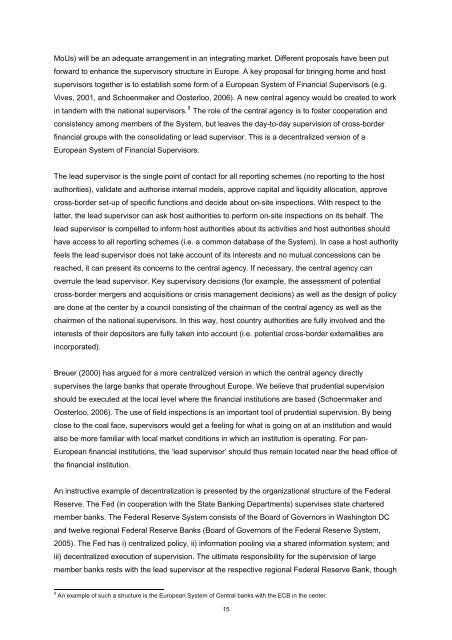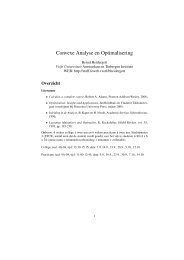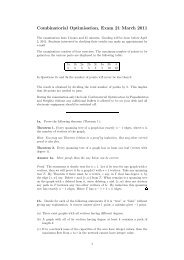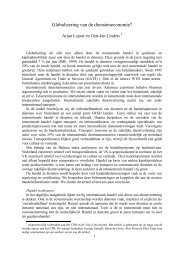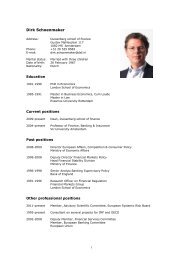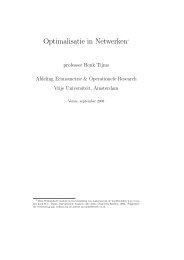Current State of Cross-Border Banking - Vrije Universiteit Amsterdam
Current State of Cross-Border Banking - Vrije Universiteit Amsterdam
Current State of Cross-Border Banking - Vrije Universiteit Amsterdam
You also want an ePaper? Increase the reach of your titles
YUMPU automatically turns print PDFs into web optimized ePapers that Google loves.
MoUs) will be an adequate arrangement in an integrating market. Different proposals have been put<br />
forward to enhance the supervisory structure in Europe. A key proposal for bringing home and host<br />
supervisors together is to establish some form <strong>of</strong> a European System <strong>of</strong> Financial Supervisors (e.g.<br />
Vives, 2001, and Schoenmaker and Oosterloo, 2006). A new central agency would be created to work<br />
in tandem with the national supervisors. 9 The role <strong>of</strong> the central agency is to foster cooperation and<br />
consistency among members <strong>of</strong> the System, but leaves the day-to-day supervision <strong>of</strong> cross-border<br />
financial groups with the consolidating or lead supervisor. This is a decentralized version <strong>of</strong> a<br />
European System <strong>of</strong> Financial Supervisors.<br />
The lead supervisor is the single point <strong>of</strong> contact for all reporting schemes (no reporting to the host<br />
authorities), validate and authorise internal models, approve capital and liquidity allocation, approve<br />
cross-border set-up <strong>of</strong> specific functions and decide about on-site inspections. With respect to the<br />
latter, the lead supervisor can ask host authorities to perform on-site inspections on its behalf. The<br />
lead supervisor is compelled to inform host authorities about its activities and host authorities should<br />
have access to all reporting schemes (i.e. a common database <strong>of</strong> the System). In case a host authority<br />
feels the lead supervisor does not take account <strong>of</strong> its interests and no mutual concessions can be<br />
reached, it can present its concerns to the central agency. If necessary, the central agency can<br />
overrule the lead supervisor. Key supervisory decisions (for example, the assessment <strong>of</strong> potential<br />
cross-border mergers and acquisitions or crisis management decisions) as well as the design <strong>of</strong> policy<br />
are done at the center by a council consisting <strong>of</strong> the chairman <strong>of</strong> the central agency as well as the<br />
chairmen <strong>of</strong> the national supervisors. In this way, host country authorities are fully involved and the<br />
interests <strong>of</strong> their depositors are fully taken into account (i.e. potential cross-border externalities are<br />
incorporated).<br />
Breuer (2000) has argued for a more centralized version in which the central agency directly<br />
supervises the large banks that operate throughout Europe. We believe that prudential supervision<br />
should be executed at the local level where the financial institutions are based (Schoenmaker and<br />
Oosterloo, 2006). The use <strong>of</strong> field inspections is an important tool <strong>of</strong> prudential supervision. By being<br />
close to the coal face, supervisors would get a feeling for what is going on at an institution and would<br />
also be more familiar with local market conditions in which an institution is operating. For pan-<br />
European financial institutions, the ‘lead supervisor’ should thus remain located near the head <strong>of</strong>fice <strong>of</strong><br />
the financial institution.<br />
An instructive example <strong>of</strong> decentralization is presented by the organizational structure <strong>of</strong> the Federal<br />
Reserve. The Fed (in cooperation with the <strong>State</strong> <strong>Banking</strong> Departments) supervises state chartered<br />
member banks. The Federal Reserve System consists <strong>of</strong> the Board <strong>of</strong> Governors in Washington DC<br />
and twelve regional Federal Reserve Banks (Board <strong>of</strong> Governors <strong>of</strong> the Federal Reserve System,<br />
2005). The Fed has i) centralized policy, ii) information pooling via a shared information system; and<br />
iii) decentralized execution <strong>of</strong> supervision. The ultimate responsibility for the supervision <strong>of</strong> large<br />
member banks rests with the lead supervisor at the respective regional Federal Reserve Bank, though<br />
9 An example <strong>of</strong> such a structure is the European System <strong>of</strong> Central banks with the ECB in the center.<br />
15


